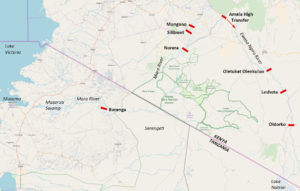by David Brewin
Cattle straying
Strains in the relationship between Tanzania and Kenya are being exacerbated by Maasai-owned cattle from Kenya straying over the border between the two countries in search of pasture. Tanzania has now taken drastic action and recently auctioned off 2,410 Kenyan cattle it had rounded up. A further 1,125 Kenyan cattle belonging to the Maasai were also seized because of a fear of the spread of bird flu. Tanzania estimates that some 30% of livestock pastures in Tanzania are consumed by cattle from neighbouring countries.
Controversy continues on GM crops
The controversy about the use of genetically modified (GM) products is widening. GM crops are banned in most of Africa and Europe but are grown in vast quantities in the Americas. Many farmers in Ethiopia, Kenya and Malawi are in favour of the use of genetically modified cotton seeds even though they are more expensive, as they provide stronger resistance against pests.
The whole dispute between users of GM crops is matched by disputes within the British Royal family according to the London Times. Princess Anne, who farms in Gloucestershire, believes that if we are going to be better at producing full value then we have to accept that genetic technology is going to be part of that. The Prince of Wales who also has several farms, is a vigorous campaigner against GM technology. Britain’s Minister of Agriculture George Eustace has stated that the British government is considering relaxing present restrictions on GM crops after Brexit, the subject which is dominating political discourse in Britain.
Poultry
Poultry breeders in Tanzania are asking the government to block imports of poultry and its products to protect their businesses. Manase Mrindwa, the Secretary General of the Tanzania Poultry Breeders Society, has stated that they have the capacity to supply about 85% of the needs of the local market and that an 18% waiver on Value Added Tax had attracted more investment in production, but that the illegal trade in eggs and newly hatched chicks from neighbouring countries was threatening the growth of the business. In October last year government authorities in Arusha destroyed 6,400 chicks imported from Kenya through the Namanga border point.
The Uluguru Grasshopper
The Uluguru Mountain Range Reserve near Morogoro has become a tourist attraction due to the presence of the Uluguru Grasshopper. The grasshopper has become known as ‘December Ninth,’ as it shares the colours of Tanzania’s national flag. Some residents are said to believe that the creators of the flag chose the colours from this grasshopper. The mountainside has been attracting visitors from across the world because of its unique flora and fauna including flying frogs, chameleons, various species of songbirds and the steppingstone used in freshwater springs.
Lake Natron
Long-standing plans to construct a Soda Ash plant on the shores of Lake Natron have been abandoned following pressure from the international community and environmentalists. The proposed $500 million plant was expected to create 500 jobs but research has shown that building a factory on the shores of Lake Natron could result in the lake drying up in about 10 years.
Support for wheat farmers
In order to end the trade war between Tanzania and Kenya, the two countries have agreed to fund part of the production costs for wheat farmers and create a commercial bank to enable wheat farmers to access loans at a 5 -6% rate of interest. These measures are being taken to improve wheat farming, improve competitiveness of the locally produced grain and curb imports of the commodity from outside East Africa.
Tea and coffee
Tea production went down in Tanzania (and also in Kenya and Uganda) last year largely because of uneven distribution of the lower amount of rainfall received in most tea growing areas.
Threat from dams
Kenya’s plan to build dams on the Mara River and its tributaries is causing growing concern in Tanzania. It believes that they pose a threat to the rich animal and plant life of the Serengeti ecosystem. The area has the river Mara as the only permanent source of water for the herds of wildebeest and other wildlife which migrate between the two countries.

